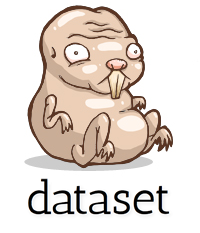dataset简介
dataset号称是为懒人所写的数据库,并说明了很多程序员存储数据都会使用不易查询和更新的CSV和JSON格式,而不是数据库,主要原因是数据库的相关代码比较复杂,而dataset正式解决这个问题,为程序员提供更方便的数据库操作

|
|
Features:
- Automatic schema: If a table or column is written that does not exist in the database, it will be created automatically.
- Upserts: Records are either created or updated, depending on whether an existing version can be found.
- Query helpers for simple queries such as
allrows in a table or alldistinctvalues across a set of columns. - Compatibility: Being built on top of SQLAlchemy,
datasetworks with all major databases, such as SQLite, PostgreSQL and MySQL. - Scripted exports: Data can be exported based on a scripted configuration, making the process easy and replicable.
dataset使用
连接数据库
|
|
插入数据
dataset会根据输入自动创建表和字段名
|
|
将产生(主键id自动生成):
| id | country | name | age | gender |
|---|---|---|---|---|
| 1 | China | John Doe | 46 | |
| 2 | France | Jane Doe | 37 | female |
更新记录
|
|
第二个参数相当于sql update语句中的where,用来过滤出需要更新的记录
事务操作
事务操作可以简单的使用上下文管理器来实现,出现异常,将会回滚
|
|
等同于:
|
|
也可以嵌套使用:
|
|
其他操作
|
|
从表获取数据
|
|
获取非重复数据
|
|
删除记录
|
|
执行SQL语句
|
|
导出数据
|
|

